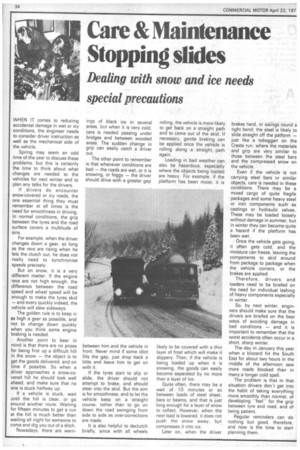Care & Maintenance Stopping slides
Page 36

If you've noticed an error in this article please click here to report it so we can fix it.
Dealing with snow and ice needs special precautions
WHEN IT comes to reducing accidental damage in wet or icy conditions, the engineer needs to consider driver instruction as well as the mechanical side of the vehicle.
Spring may seem an odd time of the year to discuss these problems, but this is certainly the time to think about what changes are needed to the vehicles for next winter and to • plan any talks for the drivers.
If drivers do encounter snow-covered or icy roads, the one essential thing they must remember at all times is the need for smoothness in driving. In normal conditions, the grip between the tyres and the road surface covers a multitude of sins.
For example, when the driver changes down a gear, so long as the revs are rising when he lets the clutch out, he does not really need to synchronise speeds precisely.
But on snow, it is a very different matter: if the engine revs are not high enough, the difference between the road speed and wheel speed will be enough to make the tyres skid — and every quickly indeed, the vehicle will slew sideways.
The golden rule is to keep in as high a gear as possible, and not to change down quickly when you think some engine braking is needed.
Another point to bear in mind is that there are no prizes for being first up a difficult hill in the snow — the object is to get the goods delivered, and on time if possible. So when a driver approaches a snow-covered hill he should look well ahead, and make sure that no one is stuck halfway up.
If a vehicle is stuck, wait until the hill is clear, or go around another route. Waiting for fifteen minutes to get a run at the hill is much better than waiting all night for someone to come and dig you out of a ditch.
Nowadays, there are warn ings of black ice in several areas, but when it is very cold, care is needed passing under bridges and between wooded areas. The sudden change in grip can easily catch a driver out.
The other point to remember is that whenever conditions are bad -the roads are wet, or it is snowing, or foggy — the driver should drive with a greater gap
between him and the vehicle in front. Never mind if some idiot .fills the gap, just drop back a little and leave him to get on with it.
If the tyres start to slip or slide, the driver should not attempt to brake, and should steer into the skid. But the aim is for smoothness, and to let the vehicle keep on a straight course, rather than to go on down the road swinging from side to side as over-corrections are made.
It is also helpful to declutch briefly, since with all wheels rolling, the vehicle is more likely to get back on a straight path and to come out of the skid. If necessary, gentle braking can be applied once the vehicle is rolling along a straight path again.
Loading in bad weather can also be hazardous, especially where the objects being loaded are heavy. For example, if the platform has been moist, it is likely to be covered with a thin layer of frost which will make it slippery. Then, if the vehicle is being loaded up when it is snowing, the goods can easily become separated by no more than a layer of ice.
Quite often, there may be a wait of 10 minutes or so between loads of steel sheet, bars or beams, and that is just long enough for a layer of snow to collect. However, when the next load is lowered, it does not push the snow away, but compresses it into ice.
Later on, when the driver brakes hard, or svi/ings round a tight bend, the steel is likely to slide straight off the patform — just like a toboggan on the Cresta run, where the materials and grip are very similar to those between the steel bars and the compressed snow on the vehicle.
Even if the vehicle is not carrying steel bars or similar objects, care is needed in these conditions. There may be a mixed cargo of quite fragile packages and some heavy steel or iron components such as castings or hydraulic valves. These may be loaded loosely without damage in summer, but in winter they can become quite a hazard if the platform has been wet.
Once the vehicle gets going, it often gets cold, and the moisture can freeze, leaving the components to skid around from package to package when the vehicle corners, or the brakes are applied.
Therefore, drivers and loaders need to be briefed on the need for individual lashing of heavy components especially in winter.
So, by next winter, engineers should make sure that the drivers are briefed on the best ways of avoiding damage in bad conditions — and it is important to remember that the worst accidents often occur in a short, sharp winter.
The day in January this year when a blizzard hit the South East for about two hours in the middle of the afternoon saw more roads blocked than in many a longer cold spell.
The problem is that in that situation drivers don't get into the habit of taking everything more smoothly than normal, of developing -feelfor the grip between tyre and road, and of being patient.
Regular reminders can do nothing but good, therefore, and now is the time to start planning them.




















































































